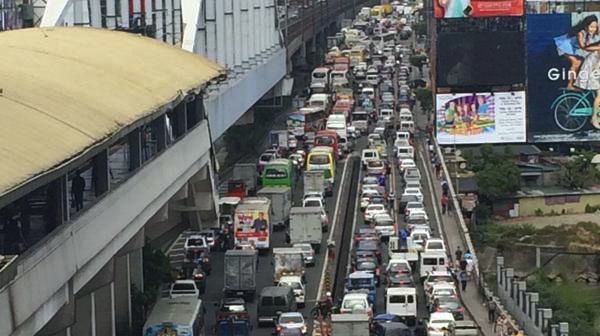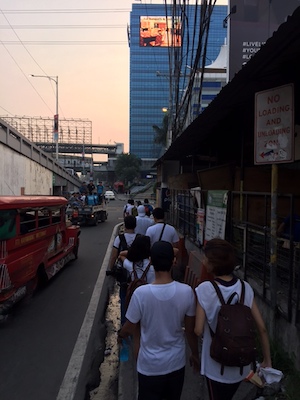
Amid the worsening traffic situation in Metro Manila, I together with fellow sustainability advocates, wanted to explore a form of mobility that’s been with us all along: walking, our first and most natural means of transportation.
Coming from different fields – art, medicine, journalism, education, business, tourism – we all have personally experienced the benefits of walking – as a form of exercise, as a practical and economical way of transportation, and as a way of seeing of the world in a different light. Thus we wanted to start a conversation about how we can make Metro Manila a walkable city, and felt that “walking the talk” was the best way to do it.
On Sunday, October 25, 2015, we walked the 21.3-kilometer stretch of EDSA, from SM Mall of Asia in Pasay to SM North Edsa in Quezon City. Starting at 5 am, the walk took us 5 and a half hours – including stops to rest, observe, listen, and talk to the people we encountered.
Here are some of the things I learned along the way:
1. There is no organized walking infrastructure. Sidewalks terminate abruptly, leaving the pedestrian unsure about how to proceed. And when they do exist, they are too narrow: in at least one section near Guadalupe, only a slim person can comfortably fit! Pedestrian lanes are also sorely lacking, misplaced, or absent where badly needed. There were areas where we didn’t even know where to pass, because there are no signs for pedestrians. For a 24/7 city, there are many sections, including overpasses, without lights, making those areas threatening, especially to individual walkers and women. And what of heavy rains and flooding? Surely in those instances, walking is even more precarious, if not impossible.

2. Pollution is really a major obstacle. The noxious air, the heat, and the noise are all forms of pollution that made the walk at times stressful. Our white shirts did not turn grey in the end, but the tissue paper did when we wiped off our faces. On a positive note, however, the trees along certain sections in Makati and Quezon City made a lot of difference in making the air breathable.
As a medical doctor, I see the potential of walking as a healthy activity (I burned around 1,500 calories during the entire walk), but we need to overcome the health risks involved – not just by wearing masks, but by making Metro Manila cleaner and greener.

3. Some pedestrians don’t follow the rules. While affirming pedestrian welfare, we saw – and do acknowledge – that pedestrians are also part of the problem when they do not follow pedestrian lanes and traffic lights. Any kind of advocacy should also focus on educating and disciplining the pedestrians themselves.
4. There are nasty drivers too – especially those who don’t respect pedestrian lanes. Once, I was nearly hit by a car that insisted on passing through the lane even when the driver saw that I was already crossing. I think we pedestrians should be very clear that the pedestrian lanes must be defended and respected. Ditto for sidewalks.

5. EDSA is built on an architecture of social injustice. Walkways are just an afterthought, like that overpass in Ortigas which isn’t even 6 feet in height. Billions are spent on our roads, benefitting those who can afford to have private vehicles, followed by those who can afford to take taxis and PUVs.
Amid all these, EDSA is home to the homeless, a workplace for the unemployed, a treacherous walkway to those who cannot afford to pay for bus and MRT tickets. In a literal and figurative sense, the poor are marginalized, and the advocacy of pedestrian welfare must also take their predicaments into account.

6. We can make EDSA beautiful. One of my fellow walkers, sustainability advocate Cherrie Atiliano pointed out that walking is much more manageable – and interesting – if there are attractions along the way. Even the sight of children’s murals along Santolan were a welcome reprieve from the billboards and the makeshift stores of Cubao. Creativity and design have a big role to play in making the roads not just walkable and safe, but also beautiful and inspiring.
7. Walkability should be "inclusive." One of the memorable sights we saw in EDSA was that of a man on a wheelchair, precariously being pushed on the highway itself as there was no sidewalk wide enough for him to pass through. Any attempt to make Metro Manila walkable should consider PWDs, the elderly, and also allow for bike lanes as part of "inclusive mobility."
8. EDSA is walkable. Metro Manila is walkable. Walking the whole EDSA may not make sense for everyday purposes, but Magallanes to Buendia was a nice, relatively clean segment with trees, and it was actually pleasant to walk on. Better yet, it took us just 30 minutes – even faster than driving the same route on a Friday rush hour! Realizing that you can actually walk some parts of Manila is an important first step in getting a “walking culture” started.

9. There is a popular demand for an advocacy to get people walking. Pedestrians comprise a majority of the population but because we have not imagined ourselves as a community, our interests have been sidelined. Yet the demand is clearly there, as evidenced by the social media attention our posts about the walk elicited. Hopefully, by organizing ourselves and speaking forcefully about this issue, we can get the government, the private sector, and all concerned to come together and work for a walkable Metro Manila.
– Rappler.com
Gideon Lasco is a medical doctor, anthropologist, mountaineer, and environmental advocate. He is author of the hiking website PinoyMountaineer.com and the Tagalog-language health website Kalusugan.PH. The project leader of “Walk Manila," an initiative for walkability and pedestrian welfare, he is inviting people to join the conversation on how to make Manila a walkable city. Connect with him at @gideonlasco or www.gideonlasco.com